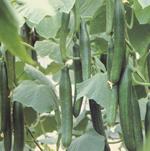| Fruits |
Vegetables
|
Cucumber, Cucumis sativus / Cucurbitaceae
|
Note: Composition for 100 g. of fresh product Values in ( min. - max. ) format. | |
| Energy: 10.00-18.00 kcal Fats: 0.10-0.60 g Fibres: 0.54-0.60 g Minerals Calcium: 10.00-18.00 mgZinc: 0.06-0.10 mg Chlorine: 17.00-37.00 mg Phosporus: 18.00-49.00 mg Iron: 0.300-0.500 mg Magnesium: 8.00-8.00 mg Manganese: 0.100-0.150 mg Potasium: 140.00-141.00 mg Selenium: 0.80-0.80 µg Sodium: 3.00-8.50 mg Iodine: 1.90-3.00 µg | Proteins: 0.60-1.40 kcal Carbohidrates: 1.50-1.81 g Liposoluble Vitamins A Retinol: 0.00-65.50 µgA Carotenoids: 60.00-393.00 µg E or Tocoferol: 0.070-0.097 mg K or Filoquinone: 16.14-16.14 µg Liposoluble Vitamins B1 or Thiamine: 0.017-0.030 mgB2 or Riboflavine: 0.010-0.030 mg B3 or Niacine: 0.20-0.60 mg B5 or Pantothenic Acid: 0.240-0.300 mg B6 or Piridoxine: 0.035-0.040 mg B9 or Folic Acid: 2.00-8.00 mg C or Ascorbic Acid: 2.00-8.00 mg |

Cucumber is a summer vegetable, with elongate shape and 15cm long. Its skin is of a green colour, turning into yellow in maturation. At present, it is found in the European markets all over the year. Fresh or pickled cucumbers are also available.
Nutrition and eating
Cucumber is a highly refreshing vegetable thanks to its water content, it has a low content of lipids, carbohydrates and proteins. The great vitamin C and B9 content is the most outstanding characteristic, along with its laxative properties and its capacity to relieve kidney disorders.
The fruit
 Cucumber is a summer vegetable, with elongate shape and 15cm long. Its skin is of a green colour, turning into yellow in maturation. At present, it is found in the European markets all over the year. Fresh or pickled cucumbers are also available. For pickling they use the small varieties of cucumber, that are commonly known as gherkin. Gherkins do not usually exceed 10cm long; they are not the only varieties used for pickling, although they are the most suitable for this process. When they are fresh, we must choose the green produce without yellow spots. Cucumbers with an excessive size usually have a bitterer taste and soft texture.
Cucumber is a summer vegetable, with elongate shape and 15cm long. Its skin is of a green colour, turning into yellow in maturation. At present, it is found in the European markets all over the year. Fresh or pickled cucumbers are also available. For pickling they use the small varieties of cucumber, that are commonly known as gherkin. Gherkins do not usually exceed 10cm long; they are not the only varieties used for pickling, although they are the most suitable for this process. When they are fresh, we must choose the green produce without yellow spots. Cucumbers with an excessive size usually have a bitterer taste and soft texture. Slightly unripe cucumbers with a thin skin are consumed without peeling. But it is always advisable to peel them and wash them well before their consumption. It is eaten in salads, cut in strips, cooked in soups and stews or in purée.
During the process of maturation, cucumbers turn into a yellow colour and their seeds grows. A good quality cucumber must be free of well-formed seeds, therefore they must be harvested before the seeds start their hardening. The harvesting must take place when the development is at the middle of its total length and the colour corresponds to a dark green with a tendency to paling.
The plant

Cucumis sativus L., the botanical name for cucumbers, is a herbaceous, creeping plant with hairy stems. The leaves are heart-shaped.
It belongs to the family of cucurbitaceous, and it is a plant of annual production. The stems are herbaceous, creeping, crawling and covered with hair; each knot of the stem has a leaf and a tendril.
The leaves have a long petiole, they are heart-shaped and the limb has 3-5 triangular lobes. The borders are sawed.
The roots are long and thin, scarcely branched.
It usually has flowers of both sexes, masculine and feminine, although breeding has centred research in obtaining plants with only feminine flowers, thus increasing the production of cucumbers per plant.
It belongs to the family of cucurbitaceous, and it is a plant of annual production. The stems are herbaceous, creeping, crawling and covered with hair; each knot of the stem has a leaf and a tendril.
The leaves have a long petiole, they are heart-shaped and the limb has 3-5 triangular lobes. The borders are sawed.
The roots are long and thin, scarcely branched.
It usually has flowers of both sexes, masculine and feminine, although breeding has centred research in obtaining plants with only feminine flowers, thus increasing the production of cucumbers per plant.
Tricks and tips
How to peel cucumbers?
In order to avoid bitter flavor, they must preferably be peeled from the petiole towards the other end
Preparing the cucumber
Cut in slices and dust with salt to remove the excess of water
| Interempresas Media, S.L. / 2025 | [ Legal notice | Política de Protección de Datos | Política de cookies | Publicidad] |
